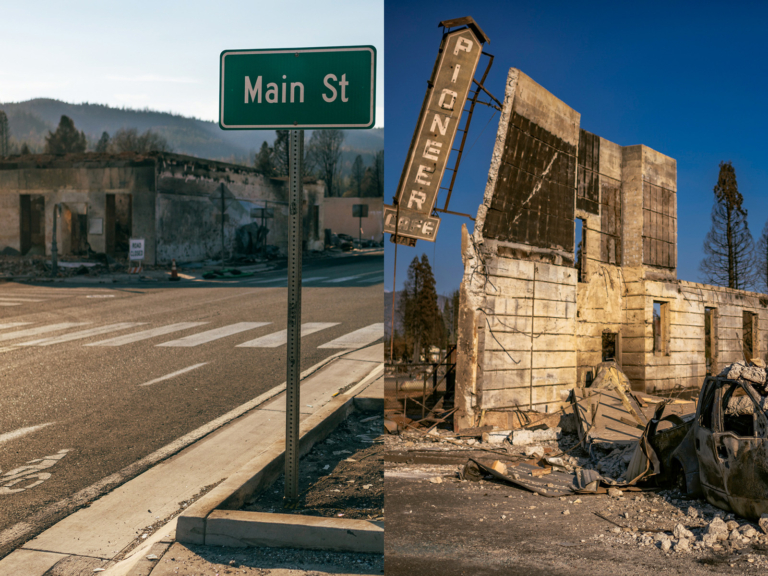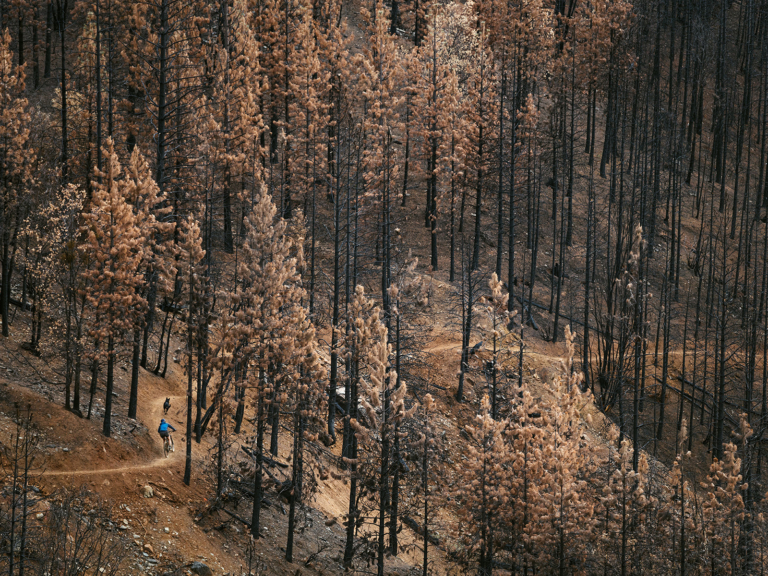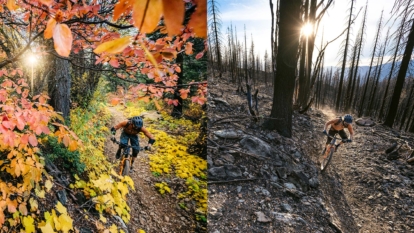Remember to Breathe
In the wake of a devastating wildfire, the communities of California’s Lost Sierra look to trails for hope, healing and a dose of dirt magic.
All photos by Ken Etzel
The smoke was so thick I could barely see the emergency vehicles’ red-and-yellow lights through my front window as they crept through downtown Quincy, California, some 100 feet away. The temperature outside topped 102 degrees Fahrenheit, but without air-conditioning it felt even hotter in the house. I’d closed the windows weeks ago to keep out the smoke, and the air was heavy, as if all the oxygen had been used up.
It was August 17, 2021, and it had been 35 days since a tree fell across a power line in the remote Feather River Canyon and sparked a small blaze. That was July 13; by July 19, the rapidly expanding Dixie Fire was throwing up a 40,000-foot-tall plume of ash as it gobbled up tens of thousands of acres of forest. By the third week of August, the fire had consumed over 500,000 acres and showed no signs of slowing down.
Almost a year and a half into the pandemic, I was already feeling isolated. Now I was trapped and getting more claustrophobic by the moment, and all I could do was stay indoors, try to stay calm and remember to breathe.
I had planned to spend the summer outside in the mountains with fellow employees and the many volunteers of the Sierra Buttes Trail Stewardship (SBTS). Based in Northern California’s Plumas County, the SBTS, which I founded in 2003, has spent the past two decades working to build sources of steady employment in a region once dependent on extractive industries like logging and mining. Using trails as the tool and working alongside local governments, communities and the US Forest Service (USFS), SBTS had managed to attract millions of state and federal grant dollars to revitalize these underserved mountain towns. We’d also built or maintained nearly 1,600 miles of singletrack in the process.
Now it was all burning.

On August 4th, 2021, the Dixie Fire—fueled by high winds and dangerously dry conditions—ripped through Greenville, California, destroying much of the small mountain town in about 30 minutes and forcing hundreds of residents to evacuate. When they returned a few days later, all that was left of the historic downtown was ash and rubble.
When the USFS closed the Plumas National Forest to the public on July 16, it immediately halted all SBTS project work and cut off access to hundreds of thousands of grant dollars we depended upon to operate. Our staff went from 72 to 13 overnight. We were forced to lay off our entire trail crew, including 30 high-school students in our Youth Crew program. Over 200 miles of trail went up in smoke; there was nothing we could do.
The Dixie Fire was officially contained on October 26, after burning 963,309 acres and becoming the second-largest wildfire in California history. It destroyed over 1,300 buildings, and more than 12,000 people were forced to evacuate. The citizens of Greenville, Canyondam and Indian Falls returned to nothing but scorched ruins and ash.
But amid all that loss, the trails continued—and can continue—to give back. During the fire, they served as entry points for firefighters and, in some cases, as anchor points for back-burns. In its aftermath, the trails could be reimagined and rebuilt as permanent and sustained fire-control lines around communities, making the area more resilient to the next inevitable conflagration.
Most important, rebuilding trails is a way to heal physically, emotionally and financially. It can be a source of pride when you’ve lost everything—something to rally around, to invest energy into, to give people hope for a future in the mountains they call home.
By late summer, things around Quincy had cooled off enough for us to develop a safety plan and hold our first workdays on the Mount Hough trail system north of town. Hundreds of volunteers showed up, in an area with a total population of barely 4,000, and in late October 2021, Mount Hough reopened to the public.
We partied. We rode bikes. At that moment, it was a celebration just to breathe.
SBTS trail crew members Ben Cruz, Kamron Williams and Tyler Marshall spent this warm October day in 2018 carving out a series of perfectly sculpted berms as part of an expansion of the Mount Hough trail system. Quincy, California.
Mason Werner and Matt Meyerl returned in 2022 to find the turns still perfect, but the manzanita and black oak had been incinerated with the rest of the area’s vegetation. Such an intense burn changes the riding experience in unexpected ways; the sounds and smells are completely different, and the fire’s devastation rules the landscape even as the hoots and yips continue.
Mandy Beatty and her SBTS trail crew flagged and carved this section of Tollgate Trail by hand, and she often rode to the worksite with tools on her back and her dog, Scout, in tow. Quincy, California.
The Dixie Fire stopped work on Tollgate Trail before SBTS crews could finish, but by the following spring, fresh oak tree stalks were already starting to push through the ash—a testament to fire’s role in renewing the landscape—and crews were able to remove hazardous burnt trees. Though loam has been replaced by ashy “moondust,” over the coming years greenery will slowly reclaim the hillsides.
When Mason Werner and Jordan Carr rode the Indian Falls Ridge trail in 2020, it meandered playfully through rock outcroppings and stands of manzanita, oak and pine, with huge views of green, conifer-covered ridgelines marching into the distance.
The fire kicked off an era of new growth in the Lost Sierra, and though the textures and colors of the landscape may have changed, the views are still spectacular and—as Mason Werner and Matt Meyerl can attest—the riding is still world-class.

The Dixie Fire revealed a whole spectrum of potential uses for the Lost Sierra’s trails: a firefighting tool during the blaze, protection against fires in the future, and a means for wildlife to travel between fragmented habitats and escape threats. Even in areas where tree mortality is highest and the landscape most denuded, the trails are a resource that continues to give back to people like Mandy Beatty (and pups, in the case of Scout) who call them home.







